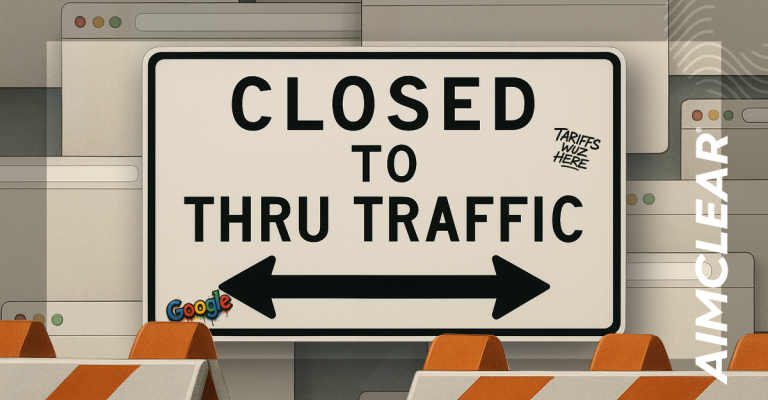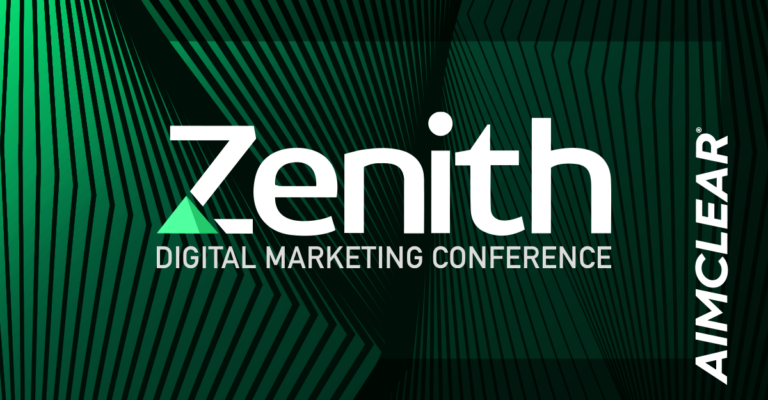
Welcome back to AIMCLEAR‘s coverage of #SESSF 2011! The Interwebz. It has changed our lives forever– the way we learn, communicate, share, and of course, shop. Thanks to powerful and ubiquitous e-Commerce functionality, we can buy sweaters, CDs, sex toys, even spaghetti take-out all from the comfort of our own homes, oftentimes in our underwear slippers.
Yes, the Internet has made shopping for this, that or the other thing easy as pie for consumers around the world. But it has also made it a potential minefield for brands. Bad Yelp reviews can populate and permeate like ink in water. Blog rants from dissatisfied customers can spring up like Super Mario Piranha Plants and gobble up slots on page 1 of Google SERPs. Or maybe the negativity takes the shape of nocent Facebook wall posts, flurries of furious tweets, etc. etc. etc. Such user generated content can track mud all over your brand’s carefully polished reputation, dissuading potential customers from buying your products or services.
The bad news: As a brand, you can’t really control whether or not such feedback exists on the web. The good news: There are actionable tactics you execute to not only save your skin in the face of an online reputation crisis, but help prepare for a similar flare up in the future, should one arise. The best news: Andy Beal, CEO of Trackur, was at Search Engine Strategies San Francisco 2011 to deliver a solo presentation jam-packed with tools, techniques & expert advice for Protecting Your Brand Online. AIMCLEAR live-tweeted this session via @beebow. Read on for the full effect.
Andy kicked off his presentation, aptly named, “Your Google Reputation Stinks! (Don’t worry, I brought air freshener!)” by answering what seems to be a burning question asked by many an attendee in the past. “Where the heck is your accent from?” Truth – Andy’s got a pretty funky hybrid accent that’s hard to put your finger on. He discloses it’s attributed to his being born & raised in England, and current residence in North Carolina. Alright, then!
On to the goods.
5 Keys to SERM (Search Engine Reputation Management)
- Rethinking keywords. Instead of trying to get two of your website’s pages to rank for a couple of keywords, SERM is about snatching up lots of KWs that are generally not that competitive. (I.E., Your company brand, or an employees’s personal name). When doing KW selection, think about your brand, and the different ways it can be expressed, or searched for by a curious potential customers. What are people typing in Google when they want to research you? Branch out – consider the name of your CEO, permutations and misspellings of your brand name, etc. Look at Google Analytics to understand what keywords are bringing people to your site. Consider these buckets when you move to optimize your content.
- Make sure your site is spider friendly. Be sure your pages / URLs include your brand name.
- Me, Myself, & Irene. Get skitzo with yourself. Think about, and write about yourself (your brand), in the third person. Move away from pronouns that side-step your brand (e.g.: “Our company does this,” “We are the best at that,” etc…). Instead, continue to mention your brand in the third person.
- Anchor text. Implement anchor text that highlights your brands, products, CEO name. This tells Google where you’re linking to. Encourage Google to keep those signals strong, that authority strong. Keep them informed about where your anchor text is going. (Big super secret-sauce tip: Don’t– DO NOT– use anchor text like “Click here.” Just. Don’t. Do. It.)
- SuperBrand to the rescue! When you type your brand name in Google, you should always come up as #1.Why do you? Because you are the SuperBrand! Google has indexed your site, and algorithmically, everything points to you as most important result for that search.
Auditing Your SERP Assets
The first thing Andy recommends is to do an audit of the SERPs that come up for your brand name. This is known as a Google Sentiment Audit. Andy recommends you audit the first 30 results of your keyword. Despite the fact that most people usually check out only the first page of results (typically, 10), you always want to know any threats or opportunities bubbling outside the first 10. Woe to the marketer who neglects page 2 of the SERPs, only to have a stinky review ranked #11 suddenly pop up as #8 on page 1.
Create an Excel spreadsheet to house the data from your audit. Include the columns:
- Rank
- URL
- Page Title
- Status
- Sentiment
Status is broken up into three options:
- Owned = Branded content you own, e.g.: your company website.
- Control = Your brand’s Facebook page. You’re the one who controls it, but you don’t OWN it (Facebook could disappear some day. If it does, so does your FB page.)
- Influenced = You don’t own it, but you can influence it. E.g., a page about you written by someone your’e partnered with.
- Third Party = You don’t own it, don’t control it, can’t influence it.
Andy recommends following the 80 / 10 / 10 rule. Spend 80% of your time & resources with owned content, 10 % on controlled, 10% on influenced.
Sentiment is broken down into three options, too:
- Positive = Good!
- Neutral = Not glowing, but not exposing any skeletons in your closet. Neutral can also be used to categorize a result that is not about your brand at all.
- Negative =Baaaaaaad.
Be honest with yourself. Ask the questions, “Would I like my customers to see this?”
So. Perform this audit for the 1st 30 results in Google. Seek out the opportunities for optimizing. Is there a bad result ranking #8? A good result ranking #11? It doesn’t take too much work to push that #11 up onto page 1 of SERPs. Booyah!
Andy recommends performing this audit at least once a month, if the seas are calm. If you’re under attack, do it every few days.
Now, onto tactics that expand upon the basic 5 keys of SERM.
“If you’ve got it, flaunt it!” Take stock of existing web content.
Which pages are relevant to your brand? Which pages bubble outside of the top 10? It’s a lot harder to optimize your pages / audit your pages if you’re knee-deep in a crisis. Results are not instant.
“An Ounce of Prevention”
Don’t wait for a crisis to hit. Act now! Here’s how:
- Do you have other company branded domains? A .org or a .net, perhaps? Put some content there! (So long as it is NOT, NOT, NOT duplicate content. Andy strongly (and wisely) recommends preparing for / optimizing your content & assets now, before a crisis strikes.
- Have a .org site? Put content on it that highlights whatever charitable work your company might do.
- Have a.net site? Put corporate information there.
- One of Andy’s favorite tactics is leveraging sub-domains.
- “They rock!” Sub-domains are treated as separate sites but still seen as linked in the eyes of Google (link juice, mmmm).
- Andy likes using sub-domains for things like, “Careers” and similar information.
- Best practice, Andy notes, is to limit sub-domains to two. Google has threatened not showing anymore than two, and, well, you never know when they might make good on that threat.
One of the keys for all of these tactics is you have to pass the Google Manual Review. Be wary of people who hate you & want to file Google Spam reports against you.
Also, remember: Any content you put on an external site has to have a legit reason for being there. It has to have depth, too! In other words, and again, to emphasize, do not just stock these sub-domains with duplicate content.
(Check out this Google SERP for “Microsoft”. The SERP is dominated by owned content. However, there are four sub-domains. Be careful!
So, moving on. What else ranks?
- WordPress.com– Useful for creating microsites, something specific for reputation management. WordPress.com could be used for your blog, your charitable initiatives site, an internal conference resource, etc. Link to this site from your homepage, or a relevant page on your main corporate site.
- This is a one-off event. You don’t have to maintain this on a consistent basis. It’s not like you built a blog. Unless you want to maintain readership. Reason you created it was for ranking purposes. not readership. so leave it alone after you create & optimize it 🙂
- Blogger.com– Nice alternative to WordPress.
- Facebook Pages – Your first goal is to create the page, then get at least 25 fans so you can claim your vanity URL. 1st goal – get at least 25 fans, then claim your vanity URL. After you do that, then decide how much engagement you want to devote to FB. This is more about a block/tackle tactic than a community management move.
- Who knows? Maybe it will turn out that Facebook is exactly the right social media channel for you to connect with your community. The most important objective here is to get the FB page to rank for your branded term.
- LinkedIn – Great for personal reputation management. Like… your CEO… who was caught leading the strip club last night… carrying a goat in his arms… Anyway, with LinkedIn profiles, you can create vanity URLs, too. Stick in Mr. CEO’s name there. Write the profile in the 3rd person, to fill in his name in there as many times as possible. Your goal: keyword density.
- While you’re at it, Andy suggests, get all your employees to create LinkedIn profiles. Give them some general guidelines. Link all the profiles up, point them back at the CEO’s profile and other corporate profiles.
- Twitter – Twitter has proactive reasons for engaging (customer support, ding ding ding!). To get your Twitter profile to rank, optimize it as you would any profile. Include your name, your bio, etc. (Do so accordingly if it’s a profile for a brand vs. a profile for that seedy CEO.)
- Andy also recommends retweeting people who @mention you, adding a “Thank you!” or something like that. People like to be thanked, but by doing this, you’re also inflating the number of times your @BrandHandle / @CEOName appears in the SERPs.
- Flickr – “Who woulda thought images would make a difference in reputation management?” Andy poses. So, why do they matter? Google wants diversity in it’s SERPs. It’s all about blended, rich media. When optimizing Flickr, make sure to have brand name as the username, optimize your vanity URL, label (caption) photos with brand name. If you post photos of employees / employers, tag them up properly.
- Tips for on-site employee bios: Don’t have one dedicated page for all of your team member / executive bios. Create a separate page for all the big gods. Optimize for each name. Add photos… embedded from Flickr. What that does is tells Google there is a third party resource associated with the image on your site.
- YouTube – Optimization very similar to Flickr. Create videos, tag them properly, embed them on your site.
- Wikipedia – WRONG! NOPE! DON’T TRY IT! Wikipedia pages rank extremely well for brand terms. But unless you already have a Wikipedia profile, it’s going to look really shady if, when you’re in the middle of a crisis, you create an account and create a branded page. Andy does not recommend doing this. Wikipedia is supposed to be an unbiased statement of fact. Even if you want to state the truth, someone will come & add in about that messy scandal you’re trying to cover up.
WetPaintCentral.com– Rather than Wikipedia, use a site like WetPaintCentral.com. It allows you to create a WIki-like page (even down the layout & elements, very similar) but only you control the content. Furthermore, you can put your WetPaintCentral.com page on a sub-domain, and name it whatever you want.AssociatedContent.com– Andy seems a little wary of it. Some of the value of AssociatedContent.com is going down.GetSatisfaction.com– A two-birds-with-one-stone type deal. Allows customers / users to ask questions, request support, engage other community members as helpful resources. Andy suggests you go get yourself a free profile, see if it starts ranking. There is also a paid model that offers moderation functionality, etc.
A lot of these sites have free 30 day trials. Try them out. See if they work. Are they ranking? Is it worth upgrading to a paid account?
- Ning.com – UCool site! Used to be free, still affordable. Ning allows you to create a social network of your own. You can point a domain name to your Ning page, decide who gets to join (employees only?), etc.
From White Hat to… Grey Hat…
These aren’t black hat… but more of a “use at your own discretion” type stuff.
- Business partners – If you have biz partners, reach out to them, ask for help / support. Ask to be mentioned on their site, on a separate page from other business partners. Slip in a little… “If you’re too busy, we’d be happy to write it!” Remember to write in the third person, and be thoughtful with anchor text.
- Sponsorships – Get yourself a company profile on any page that you offer sponsorship.
- Speaker Profiles – If you speak at a conference (big or small), ask for your own profile. Ask to write it 🙂
- Affiliates – Great affiliate don’t just write banner ads, they write whole articles about you. Work it!
Danger Zone! Be wary with these tactics. When linking to others’ content, ask yourself, “Will it always be positive?” With paid posts, getting them in times of calm is okay, but in times of crisis, it could seem shady.
If you’re already under attack… Get an early alert system set up. Google Alerts or Trackur. Keep your finger directly on the pulse of your brand mentions.
Last minute advice:
- Look beyond the first 10 results.
- Don’t panic.
- You dont get it if you dont ask.
- Be benevolent.
- Look for legal loopholes.
Alright! Great session with tip-top advice on protecting your brand online. I feel safer already! Big thanks to Andy Beal for all the top-notch tactics.
Stay tuned right here in AIMCLEAR blog for more coverage of #SESSF.








